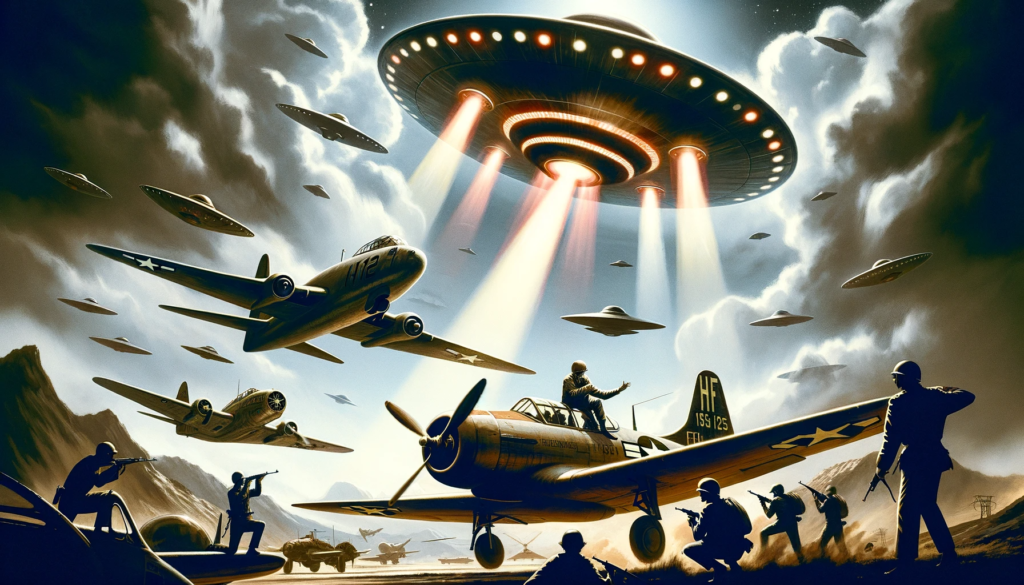Shoot Them Down! – The Flying Saucer Air Wars Of 1952

“Shoot Them Down! – The Flying Saucer Air Wars Of 1952” by Frank Feschino Jr. looks into a unique and controversial period of American history, focusing on the interactions between the U.S. military and unidentified flying objects (UFOs) during the summer of 1952.
Key Takeaways
- Record Number of UFO Sightings: The summer of 1952 witnessed an unprecedented number of UFO sightings reported across the United States. These reports, many of which were documented by Project Blue Book, form the backbone of the narrative.
- Project Blue Book’s Role: Project Blue Book, an Air Force group tasked with investigating UFO sightings, played a crucial role in documenting and analyzing these incidents. The book looks into the project’s findings and their implications.
- Military Encounters with UFOs: A significant claim in the book is the frequent encounters between U.S. military aircraft and UFOs. It describes several “hot pursuits” and engagements, offering an insight into the military’s response and tactics.
- Shoot Down Orders: One of the most controversial claims is that the U.S. military had orders to shoot down UFOs under certain circumstances. The book discusses the potential consequences and outcomes of these orders.
- Analysis of Specific Incidents: Feschino provides detailed analyses of specific encounters, including the locations, dates, and descriptions of these events, adding credibility and depth to his narrative.
- UFO Characteristics: The book describes the characteristics and behaviors of the UFOs as observed and reported, including their speed, maneuverability, and physical descriptions.
- Government and Military Responses: Feschino explores the reactions and policies of the U.S. government and military in response to the UFO phenomenon, including official statements, internal communications, and public-facing information.
- Eyewitness Accounts: The book includes numerous eyewitness accounts from civilians and military personnel, adding personal perspectives to the events.
The 1950s period saw an increased public interest and government involvement in UFO phenomena, leading to the establishment of official investigations and numerous debates and theories. The following books offer diverse perspectives on this intriguing chapter of history, from firsthand accounts to critical analyses.
In “The Report on Unidentified Flying Objects,” Edward J. Ruppelt, the first director of Project Blue Book, provides an insider’s view of the U.S. Air Force’s foray into UFO investigation. His book is a crucial resource for anyone interested in understanding the government’s stance on UFOs during the 1950s. It elucidates the methodologies, challenges, and findings of Project Blue Book, shedding light on how the U.S. military approached and interpreted these mysterious sightings. Ruppelt’s narrative offers a unique blend of factual reporting and personal insight, making it a seminal work in the field of UFO research.
“UFOs and Government: A Historical Inquiry” by Michael Swords and Robert Powell takes a broader look at the government’s response to UFO phenomena across several decades. This comprehensive book contextualizes the government’s often secretive and dismissive approach to UFO sightings. It looks into the various phases of governmental involvement, from initial curiosity and concern to skepticism and secrecy. The book is particularly enlightening in its exploration of the 1952 UFO wave, offering readers a well-rounded understanding of the political and social dynamics that influenced the government’s handling of UFO reports.
In “Project Blue Book Exposed,” Kevin D. Randle, a prominent figure in UFO research, critically examines the investigations carried out under Project Blue Book. Randle’s work stands out for its scrutiny of the limitations and controversies that plagued the project. By highlighting the shortcomings and biases in the project’s methodology, Randle presents a thought-provoking critique of the official investigations. His book is an essential read for those seeking a more nuanced and critical perspective on the U.S. government’s response to UFO sightings, particularly in the context of the investigative and political complexities of the era.
“Shoot Them Down!” is not just a recounting of events; it’s an investigation into a largely overlooked or misunderstood part of American history. Feschino’s work challenges the reader to consider the implications of these encounters, both in terms of national security and our understanding of what might be beyond our current scientific comprehension. The book’s detailed analysis of records, eyewitness accounts, and military engagements makes it a significant contribution to the field of UFO research.


